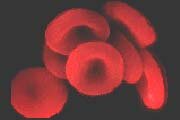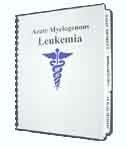 |
||
| HOME | ||
 |
||
| Acute Myelogenous Leukemia (AML) |
||
 |
||
| Other Leukemia Types (ALL / CLL / CML / HCL) |
||
 |
||
| Myelodysplastic Syndrome | ||
 |
||
| Symptoms and Diagnosis | ||
 |
||
| Leukemia Treatment Options | ||
 |
||
| " Chemotherapy | ||
 |
||
| " Blood Stem Cell Transplants | ||
 |
||
| " Radiation and Surgery | ||
 |
||
| " Chemo Side Effects | ||
 |
||
| " Clinical Trials Info | ||
 |
||
| " Coping with Leukemia | ||
 |
||
| " What to Ask Your Doctor | ||
 |
||
| Financial Assistance | ||
 |
||
| At Risk Jobs/Exposure | ||
 |
||
| Leukemia Resources | ||
 |
||
| Survivor's Story | ||
 |
||
| Leukemia News | ||
 |
||
|
Search for information:
|
||

|
Leukemia Cancer News - Return to Menu
21-Aug-2006 - CHAPEL HILL New research from the University of North Carolina at Chapel Hill has identified a molecular process in cells that is crucial to the development of two common leukemias. The findings help explain how fundamental cell processes go awry during cancer development and represent a first step toward new, targeted treatments for leukemia. Acute lymphoblastic leukemia (ALL) and acute myeloid leukemia (AML) leukemias develop when certain chromosomal abnormalities disrupt the genes that control blood cell formation. Without the proper instructions from these genes, blood cells produced by bone marrow never fully mature; these immature cells, which can't carry vital nutrients or fight infection, then flood the body. The researchers showed how a fusion of proteins created by flawed chromosomes can trigger leukemia development. The study also identified an enzyme's important role in this process. The results were published online Aug. 20 and will appear in a future print issue of the journal Nature Cell Biology. The research was led by Dr. Yi Zhang, professor of biochemistry and biophysics in the UNC School of Medicine and a Howard Hughes Medical Institute Investigator. Zhang is also a member of the UNC Lineberger Comprehensive Cancer Center. The work was supported by grants from the National Institutes of Health. The study examined chromosomal translocation, in which a fragment of a chromosome breaks off and joins another. Chromosomes are the cellular structures that carry DNA. Translocation along chromosomes can result in the generation of fusion proteins that often "misregulate" specific genes, including genes that can cause leukemia, and is a common cause of leukemia, Zhang said. The most common chromosome translocations found in leukemia patients involve the mixed lineage leukemia gene, MLL. One of the fusion proteins that partners with MLL in leukemia is AF10. AF10 has been shown to fuse with another protein, CALM, in patients with acute lymphoblastic leukemia or acute myeloid leukemia. But it has been unclear whether that fusion could cause leukemia, and little is known about how this CALM-AF10 fusion may lead to the disease, Zhang said. "Results from this study provide important insights into these questions," he said. Zhang and his colleagues showed that the CALM-AF10 fusion is "necessary and sufficient" for cellular transformation to leukemia in a mouse model of the disease. They also discovered that the fusion overactivates (also called upregulation) the gene HoxA5. Moreover, upregulation of the HoxA5 gene is necessary for cellular transformation to leukemia, the study shows. Overactive Hox genes are known to play a role in cancer, Zhang said. "In mammals, Hox genes play an important role in embryonic development. They help set the developmental pattern. They also play a role in cancer. That's why their expression must be tightly controlled." The researchers also identified an enzyme, hDOT1L, as important for upregulating gene expression by the CALM-AF10 fusion protein. This finding builds on earlier work by the Zhang laboratory involving another fusion protein, MLL-AF10, and the enzyme's upregulation of the Hox gene HoxA9. Having demonstrated the role of hDOT1L in leukemia development of two different fusion proteins, the Zhang lab is exploring the possibility of developing drugs that target the hDOT1L enzyme. "Understanding the molecular mechanism underlying leukemia development will certainly help in this endeavor, Zhang said. ### UNC co-authors include postdoctoral researchers Drs. Yuki Okada and Qi Jiang, and Lineberger Cancer Center researcher Lishan Su. Other authors are Dr. Margot Lemieux and Dr. Lucie Jeanotte from the Center for Research at Hotel-Dieu Medical Center of Quebec, in Montreal. This work was supported by grants from the National Institutes of Health. Contact: L.H. Lang
|
|
|


